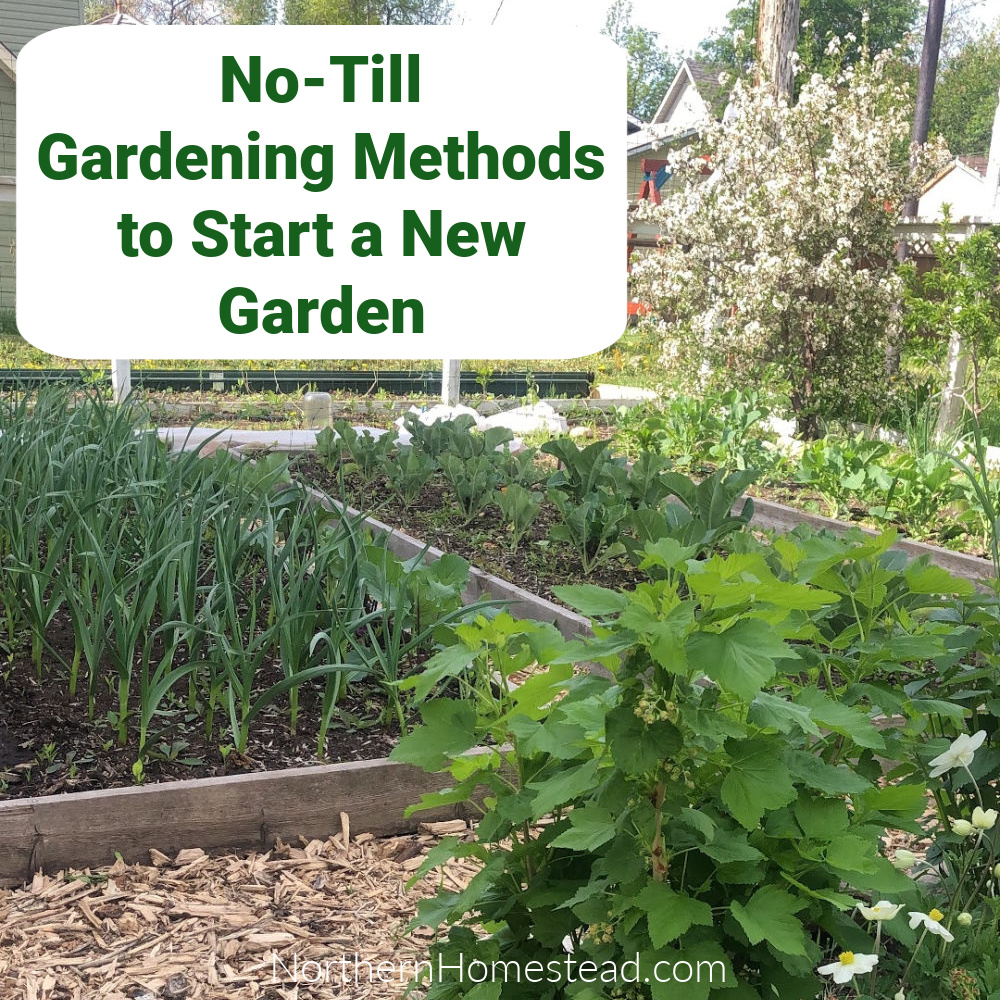
No-till or no-dig gardening methods are on the rise in popularity. The idea of starting an instant garden without the back-breaking work of digging sounds very appealing to an instant culture. Here are no-till gardening methods to start a new garden that will help you understand no-till methods and choose the best for your vegetable garden. Which one you choose depends on the soil surface, the material available, and your preference.
Examine your existing soil
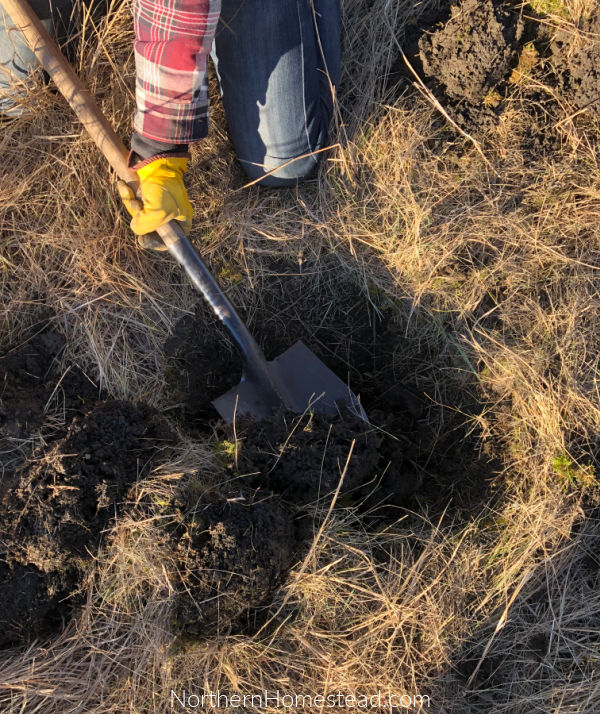
Which no-till method is best for you mostly depends on what you start with. Do a simple soil test to determine soil compaction by digging into the soil. If the soil structure is very dense, maybe has large rocks so that you have difficulty even digging a spade into it, you probably do not have healthy soil. On the other hand, sandy soil that is easy to dig up is also not fertile for gardening. In both cases, you are better off building a raised bed garden on top of the soil, like sheet mulch, hugelkultur, or the instant no-dig method.
If your soil health is good or you are converting an existing garden or field to no-till to improve soil fertility and feed soil organisms, one of the mulch methods could be a great choice for you.
The square foot gardening method also makes it possible to build a garden where there is no soil to start with, like on a driveway.
Natural Soil-Building Material Availability
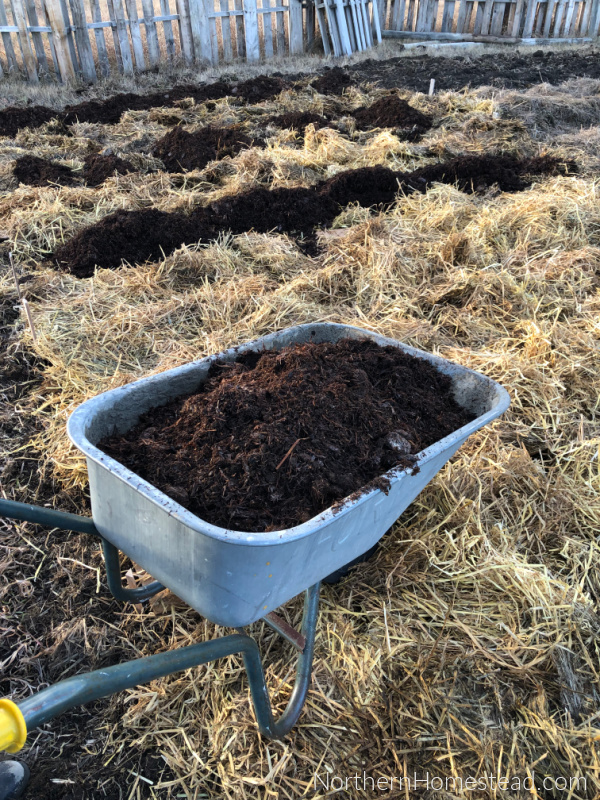
No-till gardening method compared to till methods does not mean that you just stop tilling. You have to cover the garden with natural or organic matter in no-till methods. The mulch layer is an annual must-have, just like tilling was an annual event. Over the years, once the garden is established, it will need less and less material; still, organic mulch material is always required. Once the no-till garden is built and established, grass clippings and leaf mulch can be used. Read more about maintaining a no-till garden here.
When building a new no-till garden, the layers of natural or organic soil-building materials greatly depend on accessibility. A big compost pile or lots of organic debris will allow you to build a lasagne garden or hugelkultur. If you live in grassland and have access to hay, the Ruth Stout method might be a great option. No-dig might be a better option in town, where you can only make your own compost.
All methods have their place. Use sheet mulching if you have a lot of free natural material and time to build good soil. Use compost soil mix if you want an instant garden, and square-foot gardening if you want to build a garden with no soil to start with.
1. Sheet Mulch No-Till gardening method
You can build a productive garden with sheet mulching, no matter the soil or plant roots underneath. It’s a great method to convert hay or grass fields into gardens. Also, sheet mulching is the way to go if you have rocks, sand, or clay soil.
Sheet mulch is also called lasagna gardening. Like with the yummy dish, you layer natural material to create good soil. You will benefit from more layers if the soil you cover is of poor quality.
As we said before, sheet mulching is especially attractive if you have access to natural materials for free and want to build a garden with little to no cost. However, the garden soil will take some time to become great. The first year might not bring the best results, but you will build good soil in the long run.
There are many ways to do a sheet mulched garden. As long as you use natural materials, you can hardly do it wrong. Hay, straw, compost, manure, wood chips, leaves, and twigs can all be used with good results.
The different layers will compost and blend over time, creating a very loose, rich soil, leading to less work and healthy plants over time.
Here is an example of a sheet mulched garden:
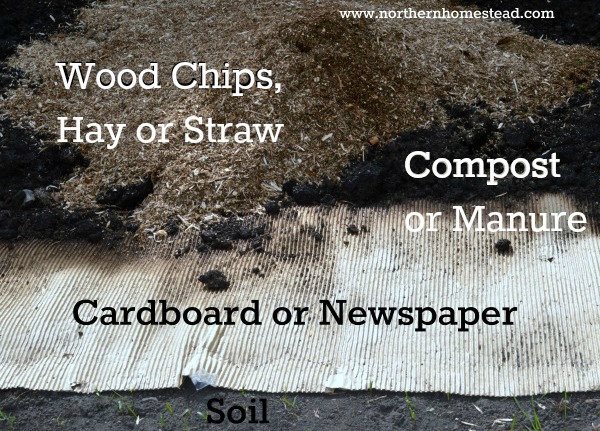
1. Begin with a cardboard or newspaper layer. Some like one more than the other; some use both. Brown cardboard is what we used. It is easy to get and simple to work with. The cardboard will prevent weeds from growing and feed the worms in the process.
After we have done it so many times, we would not insist that this step is crucial. It also works without cardboard or newspaper if you add a good layer of everything else. See how we converted a hay field into a garden.
It’s recommended to mark your walking paths and use wood chips instead of covering them with compost.
2. Layer a good amount of natural material. For example, we started with old hay in our raised garden beds.
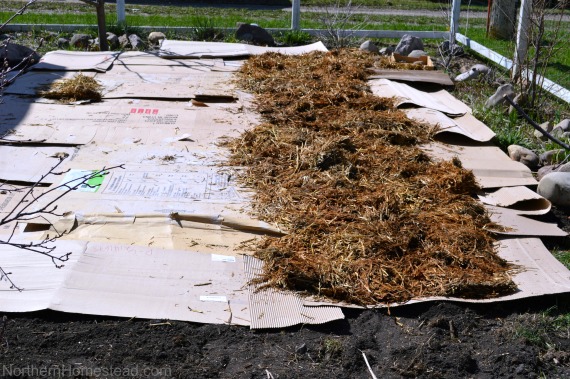
You can also use wood chips or straw as a base for the garden instead. The looser the material, the more you will need.
Cover the straw, wood chips, or hay with a layer of compost. At this point, the compost does not have to be of good quality. Composted manure is a good choice if you use wood chips. It helps to balance the carbon-nitrogen in the mix.
You can repeat the layering as many times as you want or have soil-building materials available. Sheet mulching is called lasagna gardening for a reason.
3. Top with a good finished compost about 1 inch (ca. 2-3 cm) as your growing layer. Now, you are ready to plant. You can start with cover crops or grow a vigorous plant, like potatoes.
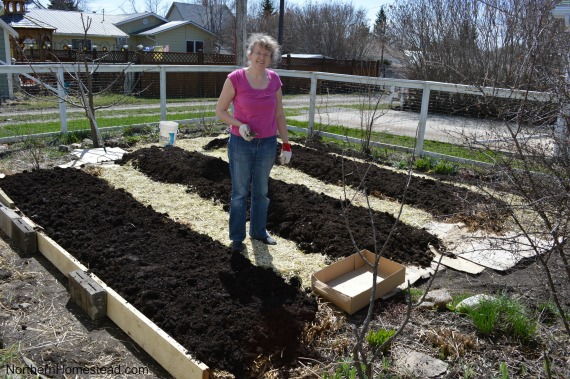
The pictures show how we built our main raised beds in the spring of 2014. We still use these beds, and the soil gets better year after year.
To maintain a sheet-mulched garden, you must mulch annually with the natural material of your choice. This can be compost, hay, straw, or wood chips. We usually use whatever is available for free.
Hugelkulture garden
The hugelkulture garden is a good option if you have lots of organic material to clean up. Here, you build a hill (what the word hugel means), starting with old wood as a brown layer, covering it with manure as a green layer, and continuing with natural material, the same as sheet mulch gardening.
Building a hugelkulture garden can be hard work and might not be the best choice for home gardeners. However, the option can be a symbiotic relationship between cleaning up and building a raised bed garden on a big property that mimics mother nature building a soil food web. It can be a fun project on a big property with heavy equipment.
2. Instant soil No-Till Gardening Method
The instant compost topsoil garden is the most common method used by no-dig gardening gurus. It is the fastest way to build a productive garden that will serve you well for many years.
As with the sheet mulch garden, you can start with a layer of cardboard or newspapers. Again, this is to have fewer weeds.
You will need a thick layer of about 6 inches (ca. 15 cm) of compost, which can be less finished. Topsoil can also be used. Since this method is coming from the UK, it is not always clear what they use since the soil there is called compost. Charles Dowding’s books are a great resource if you want to learn more.
The idea is that you build beds with soil ready for plants, unlike in the lasagne garden, which will take time to develop. Here, you bring in the soil, cover, and grow.
Again, as in the sheet mulch garden, you finish the beds with fine material. If you used compost for the base, use good-quality topsoil now. If you used topsoil for the base, using good finished compost to top with is a good idea.
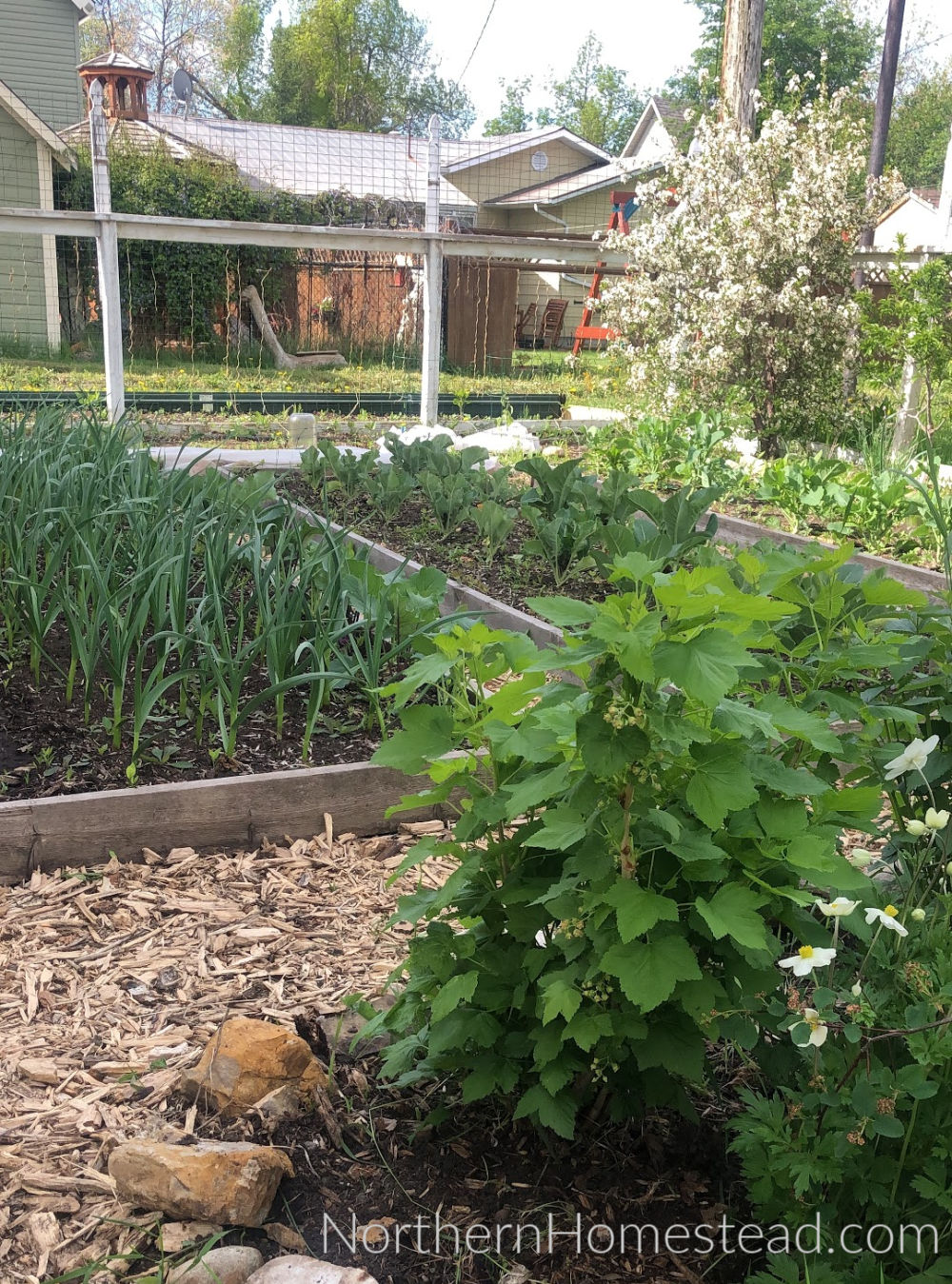
An annual mulch cover is needed to retain the effect of no-tilling. Over the years, you might need less mulch, but keeping the soil covered will always be important. Using good compost is a good choice for organic gardeners, resulting in fewer weeds. Compost as mulch is an easy way to plant small seeds.
Read more about maintaining a no-till garden here.
3. Square Foot Gardening method
I still remember when I first heard about the square-foot garden method. I looked at the person in disbelief, not even grasping what she was saying. Gardens come in rows, right? That’s all I knew at the time. It made me curious, though, and I started looking up info on the square-foot garden that she was so enthusiastic about.
There are two sides to the square-foot garden method. For one, it is a way of planting, and this is how Mel Bartholomew started it. Instead of planting a garden in long rows with lots of space in between, you plant the garden by using every square foot – hence the name. Any garden that has fertile soil can be planted this way. You can have a sheet mulched square foot garden just as well as any garden.
Instead of planting in rows, you plant in squares following a Seed-Sowing Template, giving each plant just enough room to grow. This can easily be done by hand, planting 1, 2, 4, and up to 16 plants into one square foot, depending on what you are growing.
We have found that planting too densely does not work well for cold-climate gardening. Cold plus shade works against each other. I still use the method but leave a bit more space between the squares, like a square row, or make a bit more generous squares.
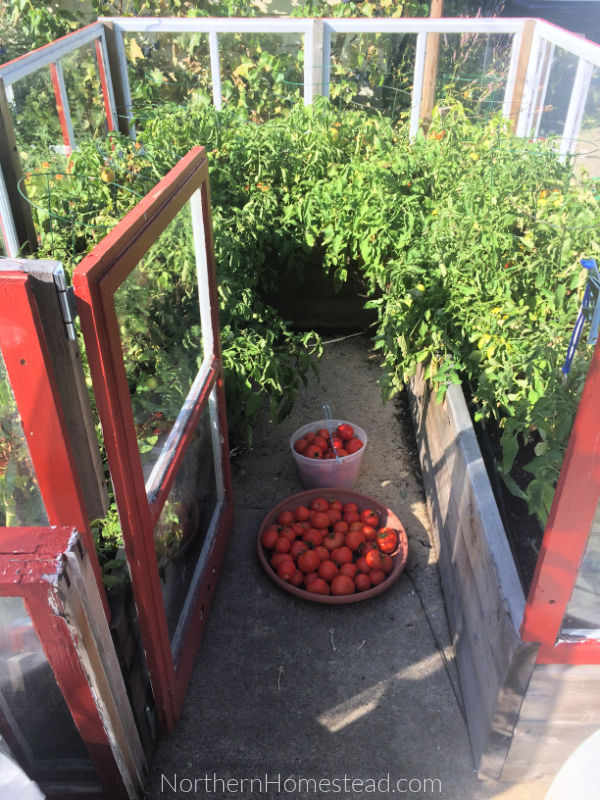
Second, the All-New Square Foot Garden is a great method if you want to build a garden without soil. Here, you build some raised beds with new soil. A square-foot garden can be built just about anywhere—on driveways, balconies, or small yards. We use Mel’s Mix in our raised garden beds and grow bags.
To make the soil for a square foot garden, combine the ingredients of Mel’s Mix:
- 1/3 compost
- 1/3 vermiculite
- 1/3 peat moss
You can find all of these ingredients in a garden center or Home Depot. The measurements are by volume, not weight. Mel’s informative books contain all the needed information. These books are great for any beginner gardener because, as we said above, any garden can be a square foot garden.
Maintaining a square-foot garden is different from other no-till gardening methods. Since we plant so densely, the garden is not mulched. Every year, a bit of compost is added to each square foot and worked in.
Mulch no-till gardening methods
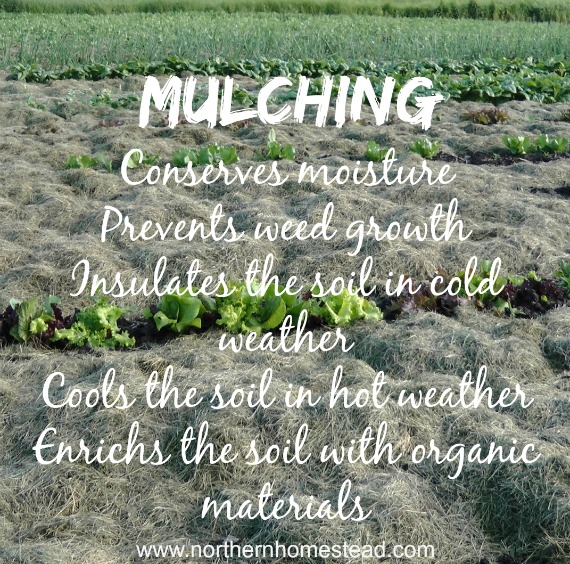
The most common types of mulch gardening are the Ruth Stout no-work system, which uses hay, and the Back to Eden method, which utilizes wood chips. Based on our experience, you will only achieve good results if the soil being covered is of high quality. There is also a risk of invasive weeds growing through the mulch, and soil building will be slow if you cover a new garden area with it. However, as with all no-till methods, beneficial organisms will eventually move in, leading to an improvement in the garden over time.
For a first garden, we recommend spending some more time or money to build good soil using sheet mulch, hugelkulture, no-dig, or square-foot gardening to have fewer weeds, less water, and healthier plants.
This blog article discusses no-till gardening methods for creating a new garden. If you already have a garden and want to convert it into a no-till garden, the article “To till or not to till the garden” is for you.
Don’t forget to subscribe to Northern Homestead and follow us on Instagram, Facebook, or Pinterest for the latest updates.

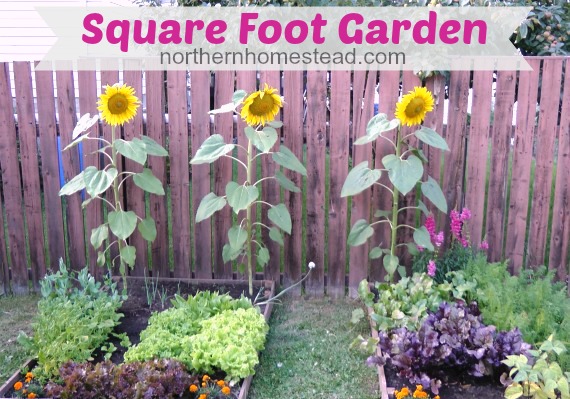
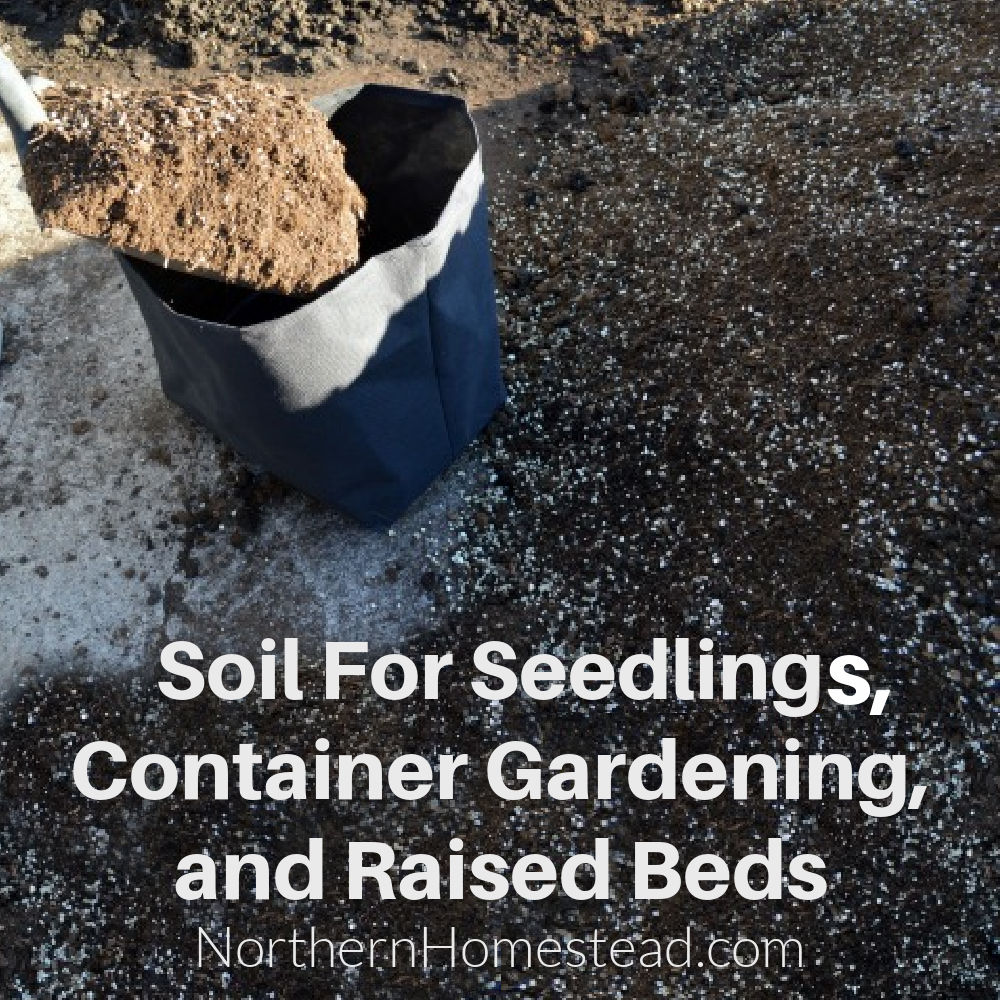
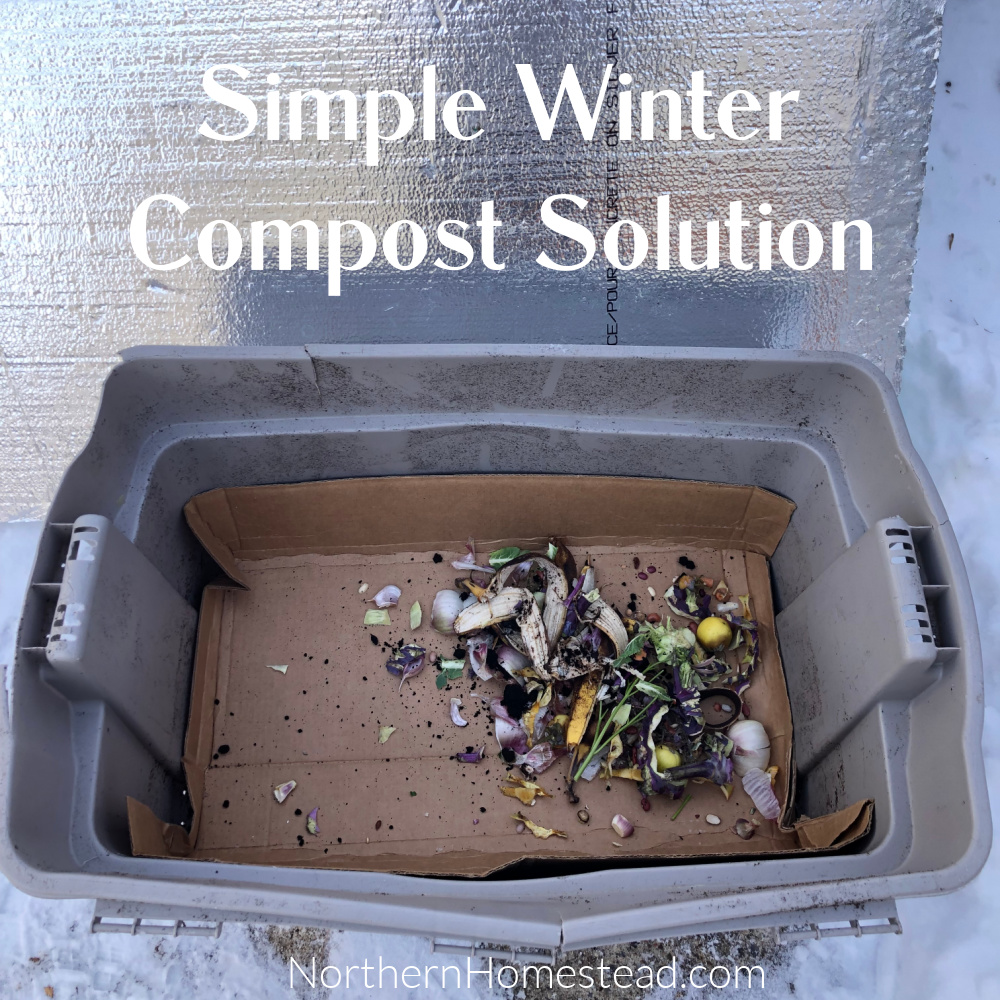
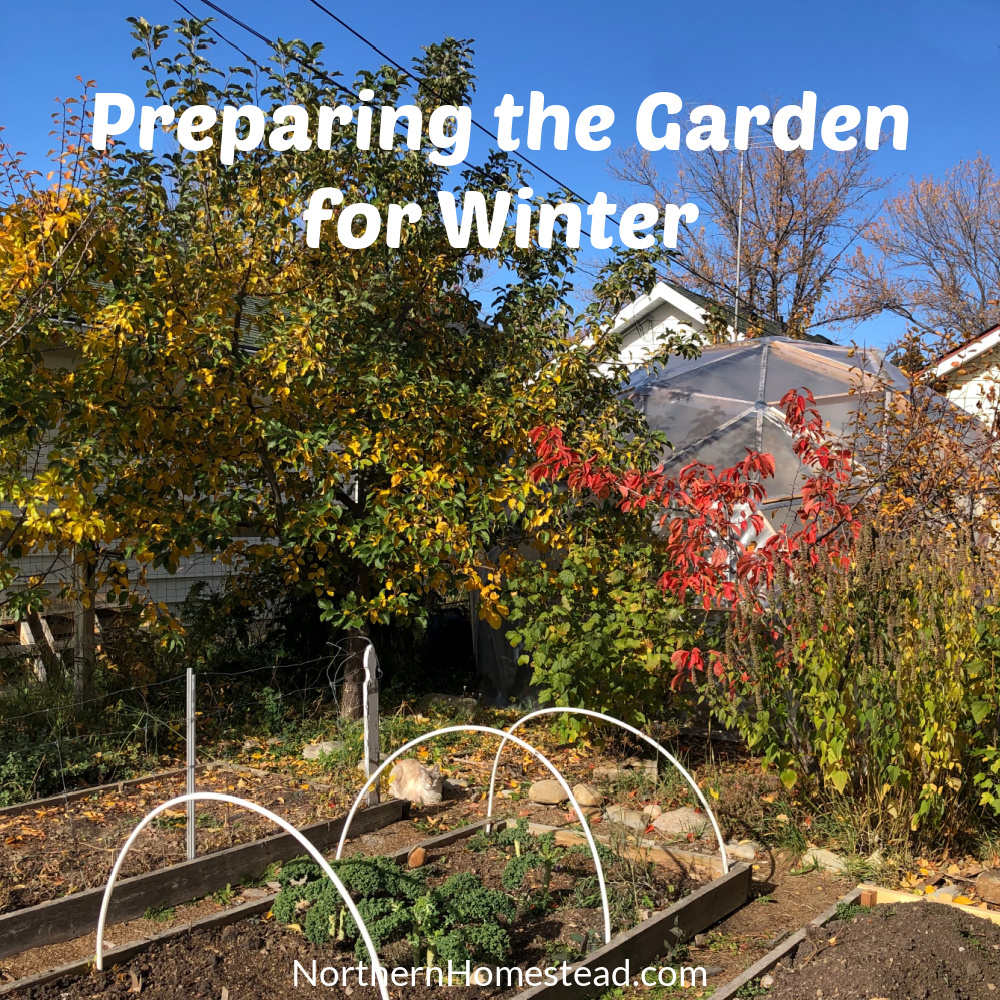
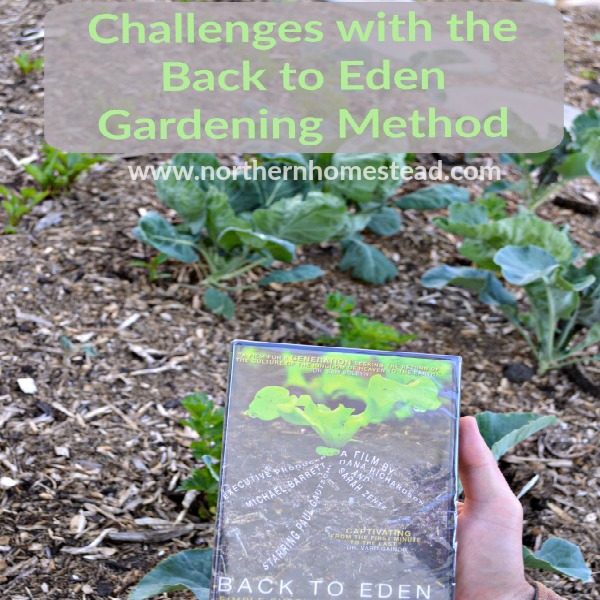
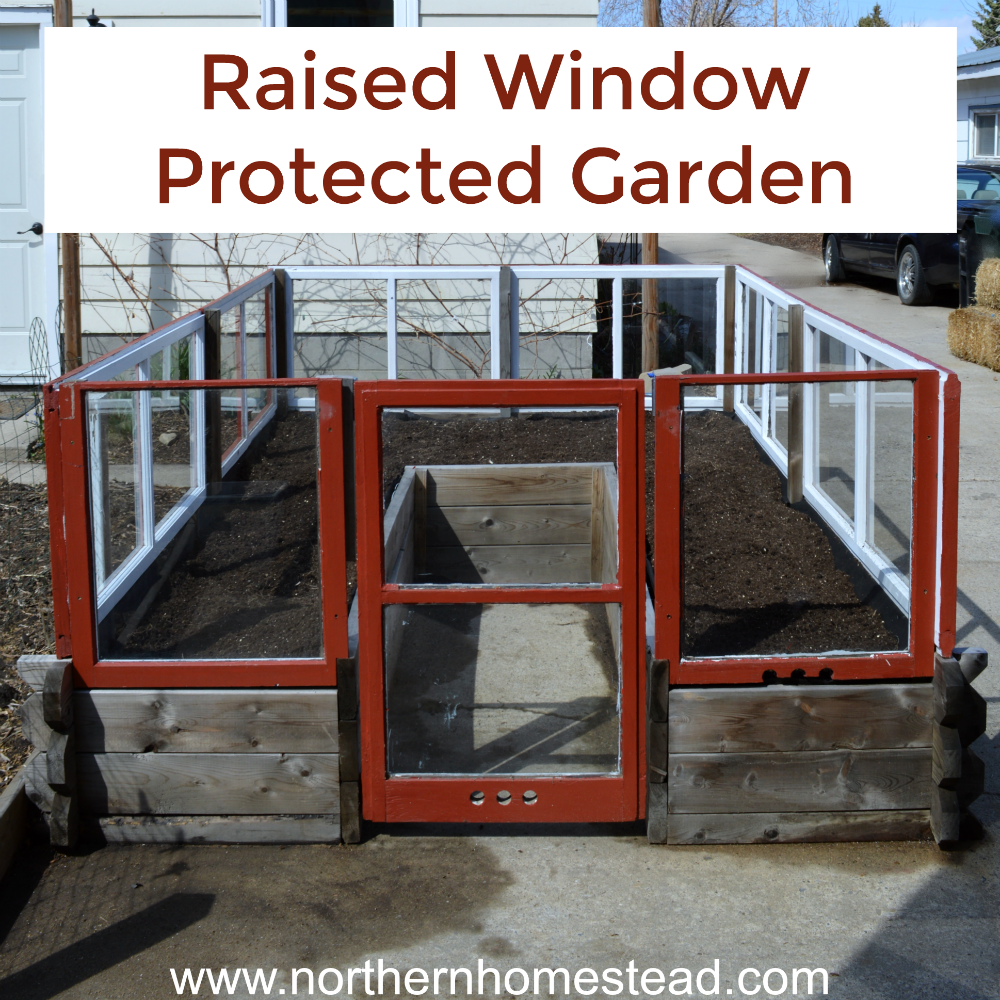
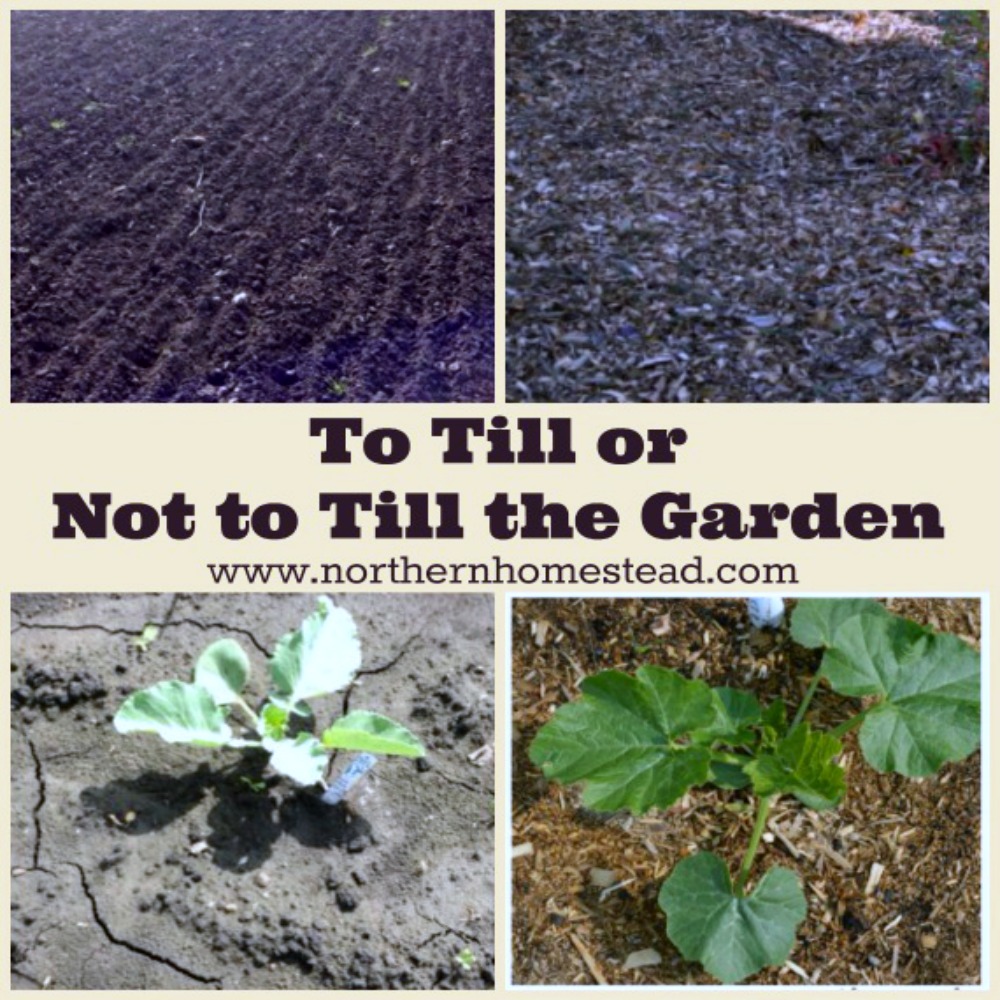
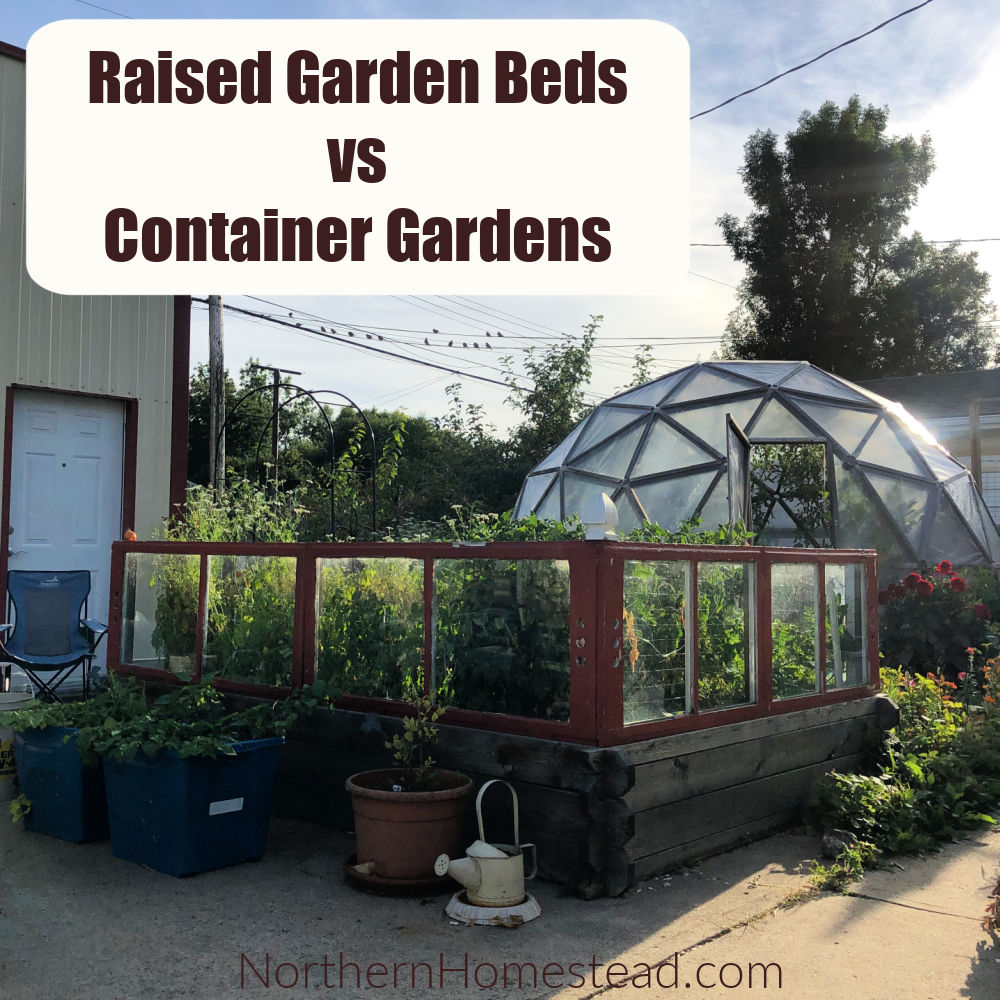
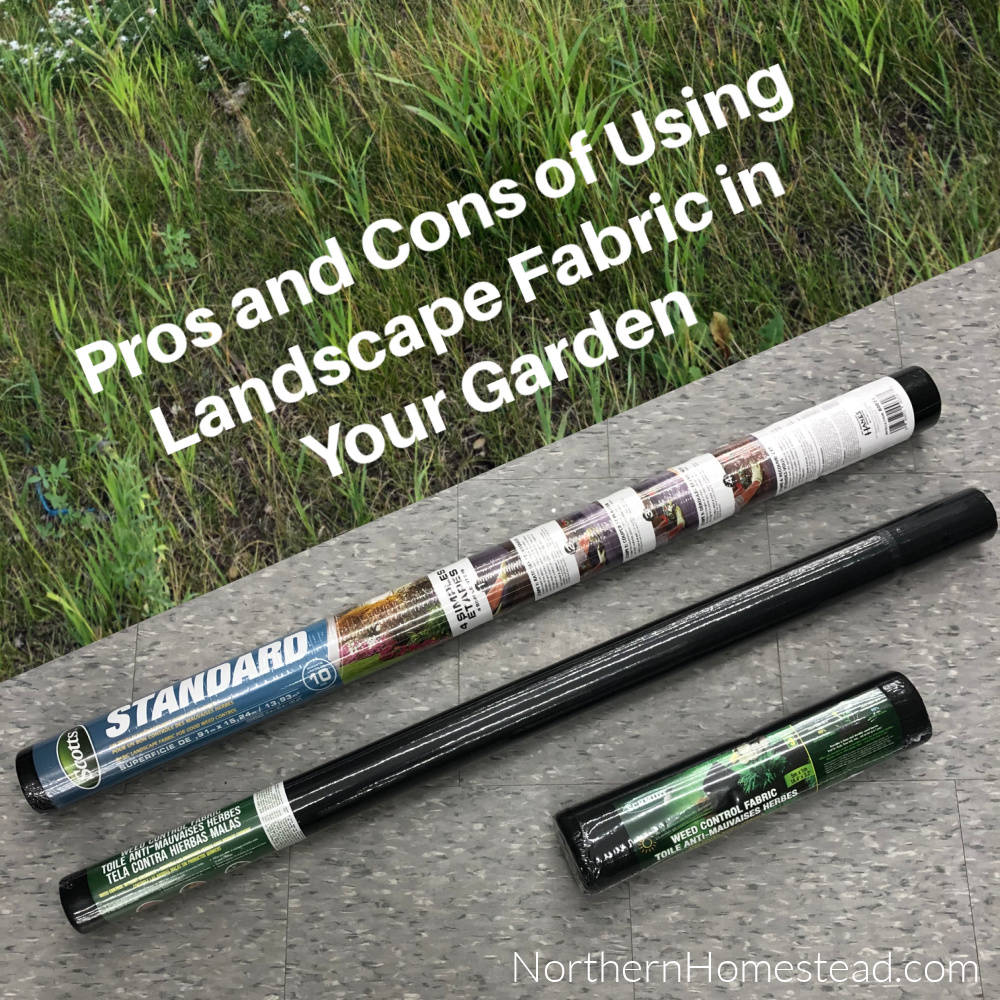
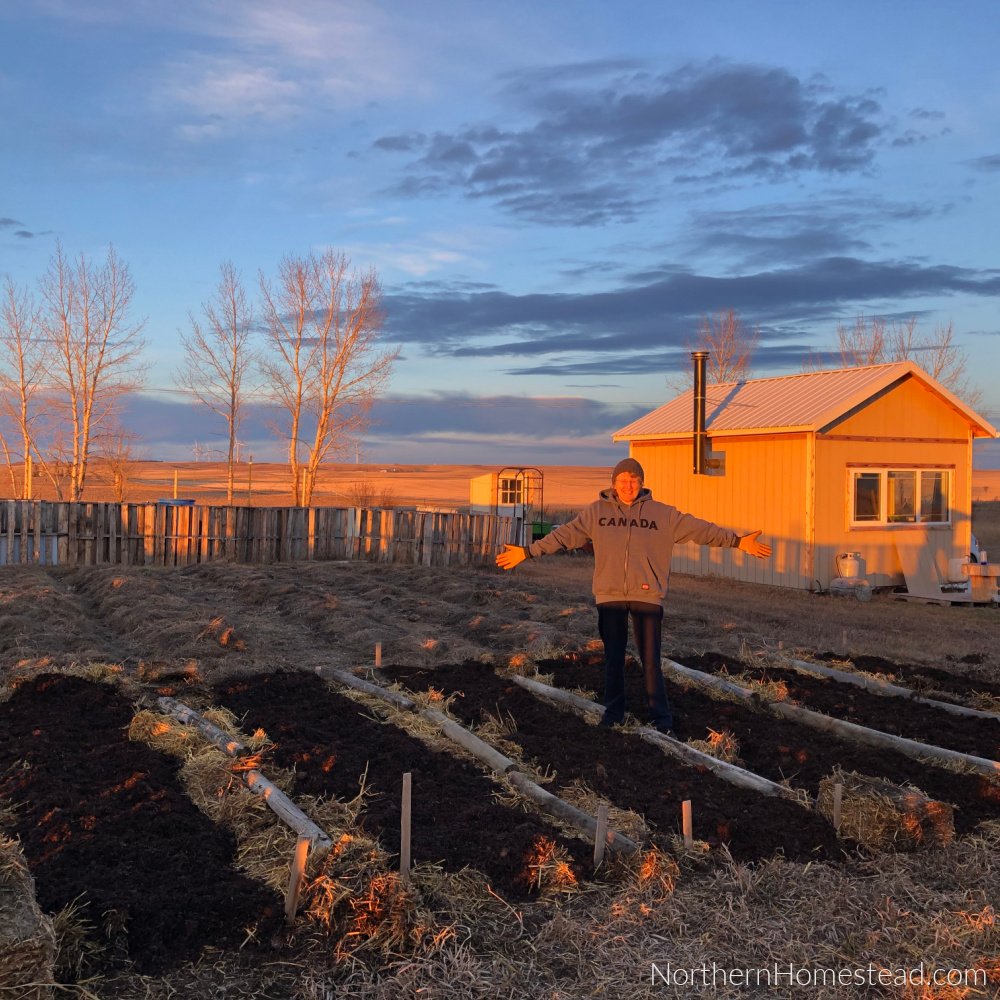

Great article! I had never heard of Eden gardening and may need to try that in my perennial beds. I never know what to do there because I hate to disturb the beautifully rooted plants.
Thanks got the To Dig or Not to Dig shout out. I hope readers find it informative. I am a firm believer that double digging has its place and time so long as you know when that place and time is.
Again, great post!
Oh yes, I think every gardener needs to watch Back to Eden. Thank you for your great post To Dig or Not to Dig. I think so too, it has its place.
Just beautiful Anna – We are finally ready to put in some raised gardens in our backyard. Will be utilizing your blog a lot in the near future 🙂
I am glad to be of some help. Have fun gardening!
I’m in the midst of spreading black wood chip mulch! My husband asked me what I wanted for Mother’s Day and I told him mulch! I’m changing from red to black. I think it looks natural and really neat. I was so excited when a truck dumped 8 yards of mulch on the tarp my husband and placed in the yard! Am I the only one who gets excited about things like that? Loved the post!
What a nice gift! Yes, I would get all excited about mulch too!
I would be careful of using dyed mulches. Natural organic mulches made from pine, spruce etc, with out any dyes are the best for both your plants and the environment. It’s not the dye, which is not bad for plants, its what they are using the dye for…to cover up the bad mulch that isn’t bark mulch at all, but ground up decks, pallets, etc….which could contain harmful chemicals….just saying, if you want a nice natural mulch, go natural! Go organic.
Valuable information, Paula! Thank you for sharing!
True. I put dyed black mulch on my garden and it burned the plant leaves. I was so upset.
I’m working on a combination of lasagna and square foot gardening 🙂 I just didn’t know it until right now LOL
Often we just do it, and then discover the name for it ;).
We have several lasagna / square foot combos. I love them. I want more. But I can’t get my husband to agree. Right now we have a 100 by 95 tilled up garden spot that is hard as a brick since it rained for days after we had it tilled. He is having a hard time accepting that both of us (due to physical problems) are not capable of traditional tilled gardening anymore . He is most worried about corn and green beans. He thinks they can’t grown in raised beds. I know green beans can. What about corn?
Yes you can grow Corn in raised beds. But if your husband likes the garden spot, keep it. But before planting put wood chips on it. The Back to Eden way. Since it is a garden plot, you do not need to start with newspapers or even compost. Just cover the area. Next spring all you will have to do is to add some manure and if needed some more wood chips. The film explains it very well. You can sell the rototiller but still have your garden the way you like it. Hope you health improves and you can enjoy it!
we did a lasagna style square foot garden. worked great!
Good to hear. We were busy all day today doing just that, some lasagne style raised beds. Will share soon!
We have been composting our garden spot for about 14 years now. You would think it would be great, wouldn’t you 🙂 Not so much. We live in an extremely sandy area, it is always a challenge. I just added some chicken manure to my composter and intend to add to red wigglers soon so it will decompose quicker. I’m a flower gardener but do have a few tomato plants which I put in pots. They will do better that way. Pinned this to my Yard and Garden board, great information!
The back to Eden garden way. Take wood chips, add at least 1/4 by measurement greens (untreated grass cuttings etc. you can put your compost in this also for the “Back to Eden” method uses tree trimmer chips which have a lot of green. This was also what I read was a good compost mixture). Put in your seeds, put the mulch to within 2 or so inches of the seeds, then water till they are big enough to receive mulch around them. Push the mulch around the plants when they are big enough. The chips/greens mixture will keep the ground great and you won’t have to compost again, the garden does it. No tilling, just add more mulch the next year. You should be able to plant right in the mulch after a year or so. Be sure the mulch is six inches deep the first year.
Great tip, Judy. Thank you! Appreciated it.
I love not till gardening and I have one of those versions. It works great. Thanks for linking up to the Bloggers Brags Pinterest Party. I’ve pinned your post to the Bloggers Brags Pinterest Board.
Thank you for hosting and pinning! We just put in the lasagne garden, waiting for wood chips to do Back to Eden.
I am staggering my Garden this year and see if that works better for me..Have lettuce and Cabbage in now and putting tomatoes, squash, cucumbers, okra and eggplant in now.. will put more in later around the first of June
Sounds great! I am in the process of planting too. So fun! Happy gardening!
I have watched the Back to Eden Film many times and have not taken the step of actually doing it yet. Our gardens are so large now I am not sure we could. I absolutely love the concept.
This is the first year we are actually doing it our self. So excited!
I really loved this post! I just wanted to let you know that I’m featuring your post on my blog today for Green Thumb Thursday. Stop over and grab a featured badge for your blog. I hope you’ll join us again this week!
Thanks,
Lisa
Oh thank you Lisa! I was so busy with the garden, that did not even see it till now. Will go over and add something new ;).
I just watched back to eden and have been busily mulching my orchard. So excited! A few of my garden beds have received the same treatment. I can’t wait to see how things grow
Good for you! We did the same thing this year. I have done wood chips on raspberries before, that worked very well. So hope everything else will be just as great.
Enjoyed this post! Just wondering if you had a hard time finding the course vermiculite for the soil mix? We are out in the hot Okanagan of BC and trying to decide between SFG or lasagna method for beds. Thanks again for all of your helpful tips/hints.
We got the vermiculite from Home and Hardware store. Personally I would go with Back to Eden and not much of a raised bed, if at all. Raised beds are great in cool climates, but in the heat of summer they tend to be dry. We love our raised beds for early crops, but overall prefer the garden covered with wood chips. Hope this is helpful.
Being a conventional gardener, I’ve plantdd raspberries a LA the University of Maine in two feet wide raised beds with municipal compost which have done well the first year.
Knowing of Ruth Stout, I’ve become better acquainted with mulching and sheet composting. I’m going to build a sheet composted bed soon in south central Pennsylvania, then plant Irish potatoes and sweet potatoes a la Peter Cullen in Growing Australia. I’ll let you know how it goes. Best wishes to all.
Look forward to hear your results, thank you!
We put a couple of pigs to eat the roots etc. They are a good fertilizer / tiller combo!
Yes they are, that might just be the reason why God created pigs ;).
Good simple article! Thanks!
Sorry to be the downer in the bunch, but it should be noted that if you have a lot of slugs in your area, no till gardening is not your friend. I learned this the hard way. I happily set up several no till garden plots, and was amazed at how quickly the soil community flourished…..but, my plants kept disappearing. I lost 4 ground cherry and 3 tomatillo plants all in one night. And, yes, I was doing it all in terms of slug patrol (nightly walks, egg shells around plants, beer baths, grapefruit lures, etc.). I just couldn’t keep up with the numbers. I started poking around my layers of straw, cardboard, etc….and there they were. All snug!!! I was basically creating slug hotels. So, I removed it all – the mulch, hay, cardboard and now my slug problem has SIGNIFICANTLY been reduced and I haven’t lost any plants. I think the no till method is fantastic, but wasn’t ideal or my location.
Thank you Trina for bringing this up. It is not the no-tilling that does not work in areas with slugs, it is the mulch you used. I address all this in the blog post: http://northernhomestead.com/challenges-with-the-back-to-eden-method/ You can still grow a no-till garden, but use compost instead of slug friendly material. There is a link to a lot more information on that post, hope it helps.
I guess I’ll add what I do… I have raised beds, use the square foot gardening method. We mulch the veggie beds with grass clipping. Then I make compost every year and we make wood chips out of all the winter blow downs that are to small for firewood. The wood chips go on the flower beds. We do live in hot Montana and I do have to water most everyday. But that is a relaxing end of the day time for me! This year I am growing more to try canning a years worth of food. I like the “high performance gardening method” too. Combine what works for you. I like reading your posts!
Hello Anna,
We are experienced gardeners living in the mountains of Kluane in the Yukon Territory. We use a blending of bio intensive, permaculture, and no till on our homestead. Our experience over time in our garden, has shown us that any mulch other than compost needs to be applied after the plants reach a certain size in early summer. When we leave other mulches covering our beds over winter we provide nesting habitat for mice and especially voles that explode in population and cause a great deal of damage to our garden. As well, mulch applied in autumn or spring has created major cut worm issues for us. There is no doubt that no till with mulching has many benefits for soil health and structure, but like any gardening method there are some limitations. Just found your site online, and after a quick perusal, I see it has many great articles for northern growers. Well done.
Thank you so much for sharing your experience. I will add your information to relevant blog posts. I think it is very valuable.
I am still confused unfortunately. No-dig gardening — just use mulch. What foes that mean? Add a layer of much and keep it there throughout the year? What about compost, do I need to add it an how often? How do I plant into mulch? So many questions here, is there a link to some clear step by step explanations on how to apply the no-dig method year after year?
Sorry, it is still confusing, even though you got it right. Yes, add a layer of mulch and keep it there throughout the year. You can use compost as mulch, or wood chips, or hay, etc. Mulch means you add it on top once a year, not working it in. If you use compost as mulch, planting into it is simple. With wood chips or hay just move it aside a bit and plant. Hope this helps. It might also be helpful to follow the links in the blog post to other articles about no-till.
What direction is the best for rows here in Alberta? And should taller crops be to the north?
Make your rows against the slop so water does not flow down the rows. If it is leveled, north-south is a good way. And yes, tall crops to the north, so they do not shade the rest.